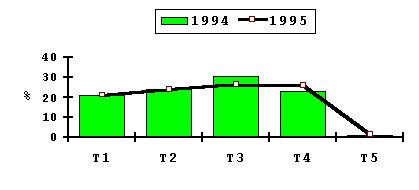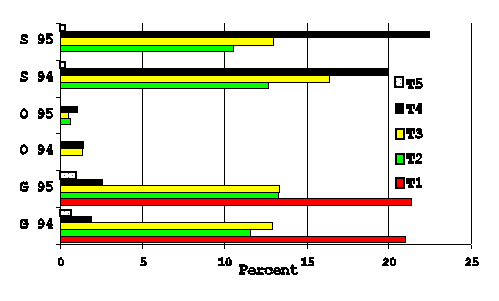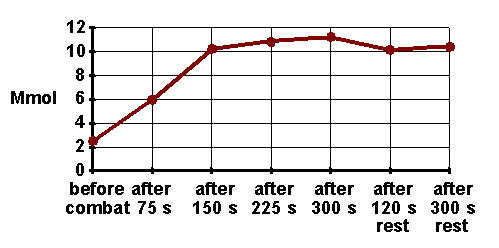Dr Stanislaw Sterkowicz and Wojciech Rukasz M.A., ANALYSIS OF THE TRAINING WORKLOAD PLAN FOR JUDO COMPETITORSINTRODUCTIONThe planning and analysis of the components in training workload is an important activity influencing a competitor’s condition in sports competitions. The proportions between the times spent on the effort, especially the periods of its greatest intensity and the periods of rest, affect the competitor’s homeostatic body balance (or bring about specific disturbances of balance), and may thus promote (or hinder) his achievement of the required level of exertion adaptation. The results of research where the aim is to determine the relationships between the doses of movement and the physiological response to them are generally recognized as the most useful in the understanding of the mechanisms of adaptation. But the same stimulation may bring about different reactions in different individuals, as is often stressed, and we can never know for certain for which of them a given type of training will generate the most favorable changes (2). No wonder, then, that an atmosphere of mystery has been built up around the trainer’s workshop methods. This has been the outcome of an insufficient level of knowledge in the training promoters themselves. It has only been the understanding of the energy mechanisms which provide the means for the performance of intensive effort of various times of duration that has given trainers a first key to the interpretation of the effects brought about in the individual sportsman by particular exertions (8,10, 7,16). A variety of internal workload indices, usually not readily obtainable in club conditions, has been applied in the laboratory testing of members of the Polish national team (5,6,11). In the practical work conducted by clubs the very simplest measurements of workload are still being used. The most often determined parameter is the relationship between the performance frequency for particular movements in a given time period (or between time of exercise at a particular intensity level), and exertive and restitutional pulse rate. Another common practice is the determination of the level of lactates in the blood (1, 7, 9). The determination of competitors’ aerobic and anaerobic thresholds is to facilitate both the selection of individual training methods, and the evaluation of the reactions to them. Moreover some observers are searching for further prognostic tests for special fitness (5, 14). Investigations on the requirements in the combat sports are of particular significance, since they may prove useful if applied in training. Galadis has examined the dynamics (rate) of lactate accumulation in the blood during a 5-minute judo combat. His purpose was to achieve a simulation for analogous workloads during training (3). Undoubtedly a systematically conducted monitoring and assessment procedure for sportsmen’s initial activities is a valuable way of verifying training curricula. What was of particular significance for us was meeting the need to integrate the information concerning the frequency, intensity, and duration of particular exercises to produce something like a model for competitors’ training activity over longer periods of time. The target in this project was to analyze the training workloads applied in the coaching of judo competitors in the high achievement range. DATA AND METHODTo obtain a systematic set of data a register was compiled of the training methods applied according to the scheme suggested by Sozañski et al. (12). The data collected were processed by the TREOB-4 software installed in the computed operating in the Department of the Combat Sports at the Cracow Academy of Physical Education. The material for analysis consisted of the exercises performed by nineteen TS Wisla judoists in the period 1994-1995 – when the team won the championship of Poland.(1) Only the training sessions in the club were taken into consideration, and members of the team who were nominated for any of the national teams were not included in the tests.(2) The judoists under observation, Group A, who did not take part in the centrally organized training system, in 1994 won 65 of their combats out of a total of 146, gaining 37.5 points; while in 1995 they had 104 wins out of a total of 204 combats, and collected 68.5 points. RESULTSA) Exercise Frequency Table 1, which presents the number of training sessions which involved both methods from the information domain as well as exercises pertaining to the five energy spheres, shows that in the two-year period under study the most often applied were the general exercises (51.3%), and special exercises (39.4%), while the oriented exercises were only rarely used (8.6%). In the energy domain the most frequent were the T1 assisting exercises (27.3%), followed by T3 mixed (i.e. anaerobic/aerobic) exercises (23.4%), T4 anaerobic/lactic acid exercises (21.4%), T2 aerobic exercises (20.8%), while T5 anaerobic lactic acid-free exercises were not so common (7.1%). No significant deviation was found between the respective structure indices for 1994 and 1995 (0.501 and 0.449) for the frequency of the general exercises, which occurred a total of 443 times. Similarly there was no significant deviation between the respective figures for frequency of oriented exercises (0.459 and 0.541, for n = 74). Special exercises were performed less frequently in 1995 than in 1994 (0.468 and 0.532, for n = 340). There was no significant deviation in the results for the exercises grouped according to the T1-T5 energy criteria for 1994 and 1995.(3) B) Intensity of Training Means When the time factor for the duration of the exercises was taken into account, a somewhat different workload structure was observed for the information domain. The changes involved a reduction in the overall training duration – 12,475 min. for 1995 as compared to 13,790 min. for 1994, chiefly at the expense of special and oriented exercises (Table 2). Figure 1 shows the overall training workload for the examined group of TS Wisla competitors for 1994 and 1995 in terms of five intensity spheres. It was observed that with respect to 1994, in 1995 there was a statistically significant decrease in the time spent on training methods in the T3 intensity range, in favor of higher intensity ranges, T4 and T5, while the percentage contribution of T1 assisting exercises and T2 exercises stimulating aerobic effort potential remained unchanged. As regards the competitors’ general skills (where t = 13,047 min.), the dominant type was the assisting exercises, which accounted for 42.6%. The proportion of exercises involving aerobic changes was 24.9%, and 26.4% of the mixed exercises. Training methods promoting anaerobic energy changes accounted for only 6.2% (4.5% lactic acid changes and 1.7% lactic acid-free). In 1995 a decrease was observed in the time spent on exercises which enhanced assisting and mixed energy processes. At the same time there was a rise in the proportion of anaerobic methods (Table 2 and Figure 2). In the oriented skills sphere, with t = 666 min., the dominant form were the exercises inducing anaerobic lactic acid changes (48.8%); the exercises involving mixed energy changes made up 37.8%; while the aerobic methods accounted for only 13.4% of the time. The time spent on these exercises was considerably shorter than for the corresponding exercises in the general and special spheres. In 1995 an increase was noted in the time spent on methods in the second intensity range (aerobic), and a fall in the time spent on methods in the third and fourth intensity ranges (Table 2 and Figure 2). The special skills sphere, for which t = 12,549 min., was characterized by a preponderance of exercises stimulating glycolytic anaerobic changes (44.1%). Methods training aerobic-anaerobic energy mechanisms accounted for 30.9%, while the methods affecting aerobic mechanisms made up 24.3%. Speed exercises, which develop anaerobic lactic acid-free energy mechanisms, constituted only 0.66% of the time for special methods. In comparison with 1994, in 1995 – by analogy with the situation for the general sphere – a partial replacement was observed of the methods stimulating aerobic and mixed energy-change processes by special exercises in range 4, which approximate to the combat situation (Table 2, Figure 2). DISCUSSIONThe physiological background to combat in competitions and the exercises which simulate combat in terms of objective structure (the information domain) and time structure (the energy domain) lies in the lactic acid energy changes (range 4). Hence methods engaging these mechanisms were the methods predominantly applied in the training curricula. The data quoted in the literature show that for competitors in Poland’s national team the lactate concentration following combat lay in the range from 15.2 to 17.3 (5). Galadis noted a lower LA concentration, 10.4 mmol/l, for 10 competitors in a university team. This might have been associated with a lower level of sports achievement (according to Eaton -3). Judo combats may finish before the regulation time of 5 minutes is up, and hence it would be advisable to monitor the rate of increase for LA concentration during the exertion (Figure 3). The coefficient for LA concentration prior to combat amounted to 2.52 (SE) 0,66. After 75 seconds of exertion it was 5.98 1.19; 10.20 0.97 after 150 seconds; 10.84 0.71 after 225 seconds; and 11.22 1.22 mmol/l after 300 seconds of combat. After 120 seconds of rest LA concentration was 10.10 0.97; and after five minutes’ rest it was 10.40 0,87 mmol/l (3). Judo competitors in the high achievement range should be characterized by an ability to work in conditions of fairly high muscle acidity. This is why training methods are selected which simulate combat in terms of their nature and intensity, that is in range 4 (as shown in the TREOB-4 analysis). The time allocated for general in the TS Wisla club was almost equal to the time set aside for special methods; while the proportion of oriented exercises in the full training workload was negligible. By comparison, in cross-country skiing, which calls for a high level of development in competitors’ oxygen potential, the largest contribution has been observed to come from methods enhancing the aerobic mechanism of energy change (in range 2), and the smallest from exercises stimulating the glycolytic processes (4). A definitive answer to the question of the alleged correlation between the achievements and workloads effected by TS Wisla judoists during training sessions in 1994 and 1995 would be highly interesting. Whereas the points won by this team in 1995 were indeed greater than what they achieved in 1994 in terms of the structure indices observed (0.646 > 0.354; p. < 0.05), it would nevertheless be unreasonable to attribute this fact merely to different proportions of training workload. While the combats fought in the 1994 training cycle may be regarded as a dependent variable, ignoring these highly specific workloads in a retrospective analysis of the two years would be untenable. Tournament combats provide high-scoring competitors with an extremely useful form of training. But the workload a competitor accrues in combat in any given year may affect his results for the next year’s starting activity. It does not appear viable to simulate all the conditions that occur in combat in the training situation. We are of the opinion that no definitive conclusions can be drawn on the basis of the material available. Before such conclusions might be reached it would be necessary to carry out individual analyses of particular competitors’ workloads during training and combat, and to augment the range of research with results observed for their respective parameters for technical and tactical skills, body build, fitness, etc., and also to take their opponents into account. LITERATURE1. Andreyev, W.M., E.A. Matvieyeva, V.I. Sytnik, & G.G. Ratishvili, “Opriedelienye intiensivonsti trienirovochnoy nagruzki w borbie dzhudo”. Sportivnaya Borba, 1974, p. 13. 2. Bouchard, C., & R.J. Shephard, “Physical Activity, Fitness, and Health. The Model and Key Concepts”, International Proceedings and Consensus Statements, Leeds: Human Kinetics Inc., 1994, p. 77. 3. Eaton, P. Discussion of All Aspects of Traditional and Modern Judo, <[email protected]> Fri. 18 Apr. 1997. 4. Krasicki, S., Próba optymalizacji treningu sportowego biegaczy i biegaczek narciarskich [An Attempt to Optimise the Sports Training of Male and Female Cross-Country Skiers], Wyd. Mon. AWF w Krakowie, No. 70, 1996. 5. Lerczak, K., M. Rzepkiewicz, W. Borowiak, & D. Lerczak, “Test rzutowy jako próba specificzna w treningu” [The Special Fitness Test in Training], Trening, 1996, No. 3, p. 31. 6. Mickiewicz, G., J.Starczewska, & L. Borkowski, “Physiological Characteristics of Polish National Team Judoists in 1981-1987”. Contemporary Problems of Training and Judo Contests. International Congress on Judo, 9-11 November, Spaa, Poland, 1987, p. 35. 7. Müller-Deck, H., “Reflection of Different Factors of the Performance in the Judo Competition as a Result of Systematic Investigations and Observations”. Contemporary Problems of Training and Judo Contests. International Congress on Judo, 9-11 November, Spaa, Poland, p. 50. 8. Newsholm, E.A., “Application of Knowledge of Metabolic Integration to the Problem of Metabolic Limitation in Sprints, Middle Distance and Marathon Running. Principles of Exercise Biochemistry.” Med. Sport Sci., Ed. J.R. Portmans, Vol. 27. 1988, Basel: Karger, p.194. 9. Pismienskiy, I.A., Y.K. Kobliev, & V.I. Sytnik, Mnogolietniaya podgotovka dzhudoistov, Moskva: Fizkultura i Sport 1982. 10. Sahlin, K., Metabolic “Changes Limiting Muscle Performance”, (in): International Series on Sports Sciences, Vol. 16, Biochemistry of Exercise VI, ed. B. Saltin, Champaigne, Illinois: Human Kinetics Publishers , 1986, p.323. 11. Sikorski, W., “Aktualne problemy treningu i walki sportowej judo” [Contemporary Problems in Judo Training and Combat]. Prace i Materiay Instytutu Sportu w Warszawie, Vol. 5. 12. Sozañski, H., A. Kosmol, & F. Siwko, “Jak analizowaæ dynamikê obcilzeñ treningowych w makrocyklu” [How To Analyse the Dynamics of Training Workload in the Macrocycle], Trening, 1991, No.2, p.8. 13. Sterkowicz, S., “Czynnoci zawodowe trenera judo” [The Judo Trainer’s Professional Activities], Trening, 1995, No. 3, p. 58. 14. Sterkowicz, S. “W poszukiwaniu nowego testu specjalnej sprawnoci ruchowej w judo” [In Search of a New Special Judo Fitness Test], Trening, 1996, No. 3, p. 46. 15. Wolkow, N.I, “Bioenergetyczne podstawy i ocena wytrzymaloci” [The Bioenergetic Principles and Assessment of Endurance], Sport Wyczynowy, 1989, No. 7-8, p. 7. 16. Wolkow, N.I, & W.M. Koriagin, “Z badañ nad kryterium klasyfikacji obcleñ treningowych” [Investigations of the Criterion for Classification of Training Workloads], Sport Wyczynowy, 1977, No.7. Table 1: Comparison of training methods applied by TS Wisla judo competitors in 1994 and 1995 according to information domain & energy domain
Table 2: Time spent on training methods in the information and energy domains, by TS Wisla judoists in 1994/1995 (in minutes)
Figure 1. Judoists’ training workload structure for 1994 (t = 13,790 min.), and 1995 (t= 12,472 min.)
Figure 2. Percentage contribution of training methods in annual workloads for 1994 and 1995 (t1994 = 13,790 min.; t1995 = 12,472 min.) [S; O ; G – Special/Oriented/General]
Figure 3. Rate of increase for LA concentration coefficient during judo combat (after Eaton, 1997) FOOTNOTES1. The team’s TS Wisla trainer , Mr M. Tabaszewski, kindly made the training records accessible to us. 2. In each of the seasons there were five league games, and the full team won 123 points in 1994 and 179 points in 1995 3. A level of p.< 0.05 was assumed. |
“Before and after practicing Judo or engaging in a match, opponents bow to each other. Bowing is an expression of gratitude and respect. In effect, you are thanking your opponent for giving you the opportunity to improve your technique.” |



